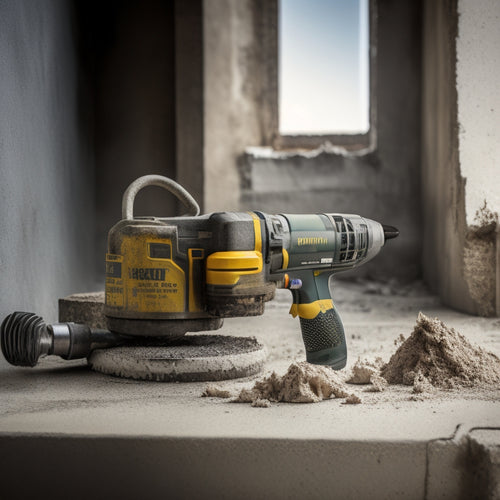
Why Renovation Waste Disposal Harms the Environment
Share
When you undertake a renovation project, you're contributing to a staggering problem: renovation waste disposal, which accounts for a significant portion of the total waste sent to landfills, releasing greenhouse gases, toxic chemicals, and pollutants that harm the environment and human health. You're generating massive amounts of waste, including concrete and asphalt that release greenhouse gases, and toxic chemicals that contaminate soil and groundwater, posing health risks and environmental threats. Unfortunately, improper waste disposal leads to habitat destruction, air quality degradation, and water pollution, which can be devastating. As you investigate the environmental implications of renovation waste, you'll uncover more surprising consequences.
Key Takeaways
- Renovation waste disposal contributes to over 40% of total waste in landfills, leading to increased greenhouse gas emissions and climate change.
- Toxic chemicals in renovation waste contaminate soil and groundwater, posing health risks and environmental threats to local ecosystems and wildlife.
- Improper disposal of renovation waste leads to water pollution in aquatic ecosystems, harming aquatic life and human health through contaminated runoff.
- Air pollutants released during renovation activities aggravate respiratory issues and cardiovascular problems, contributing to poor indoor and outdoor air quality.
- Habitat destruction and erosion occur due to improper disposal of renovation waste, disrupting ecosystem balance and reducing biodiversity.
Waste Disposal's Carbon Footprint
As the world shifts towards sustainable living, the carbon footprint of waste disposal has become a pressing concern.
You're likely aware that the construction industry is a major contributor to waste generation, and renovation projects are no exception. The disposal of materials like concrete, asphalt, and wood products results in massive amounts of greenhouse gas emissions. When sent to landfills, these materials decompose and release methane, a potent greenhouse gas.
Fortunately, you can reduce your carbon footprint by adopting recycling alternatives. For instance, recycling concrete and asphalt can conserve natural resources, reduce landfill waste, and decrease the energy required to produce new materials.
Implementing sustainable practices, such as reusing materials on-site or donating usable materials to local charities, can also greatly minimize waste. By adopting these strategies, you can minimize the environmental impacts associated with waste disposal and contribute to a more sustainable future.
Toxic Chemicals in Landfills
When you send renovation waste to landfills, you're not just burying inert materials - you're also disposing of toxic chemicals that can contaminate soil and groundwater.
These chemicals, such as heavy metals, volatile organic compounds (VOCs), and pesticides, can leach into the soil and migrate to nearby water sources, posing a significant threat to both human health and the environment.
Exposure to these toxic chemicals can cause a range of health problems, from respiratory issues to neurological damage.
Additionally, the toxic exposure can also have devastating effects on local ecosystems, as contaminated soil and water can harm plants and animals.
Effective landfill management is essential to mitigate these risks. This includes implementing proper waste segregation, using impermeable liners, and monitoring leachate collection systems.
Habitat Destruction and Erosion
When you dispose of renovation waste improperly, you're contributing to soil quality degradation through the introduction of contaminants and altered soil compositions.
This degradation can have a ripple effect, disrupting wildlife habitats and threatening the delicate balance of ecosystems.
As you'll see, the consequences of habitat destruction and erosion can be far-reaching and devastating.
Soil Quality Degradation
One of the most pressing concerns related to soil quality degradation is habitat destruction, which occurs when renovation waste is inadequately disposed of and contaminates soil.
When you improperly dispose of renovation waste, it can lead to soil erosion, which is the wearing away of topsoil, reducing its fertility and affecting its ability to support plant growth. This, in turn, accelerates nutrient depletion, making it difficult for plants to thrive. As a result, the soil's natural balance is disrupted, leading to a decline in soil quality.
You may not realize it, but your renovation waste disposal habits have a direct impact on the soil's ecosystem. Contaminated soil can't support the complex network of microorganisms, insects, and other organisms that call it home.
This can have a ripple effect throughout the entire ecosystem, leading to long-term environmental damage. It's crucial to understand the importance of proper renovation waste disposal to prevent soil quality degradation and its far-reaching consequences.
Wildlife Habitat Disruption
You're likely unaware that your renovation waste disposal habits have a significant impact on local wildlife habitats. The improper disposal of waste materials can lead to habitat destruction and erosion, disrupting the delicate balance of ecosystems. This, in turn, affects species migration patterns, causing them to relocate or even become extinct.
When waste isn't disposed of properly, it can contaminate soil and water sources, making it difficult for plants and animals to survive. This can have a ripple effect throughout the ecosystem, leading to a decline in biodiversity and ecosystem balance.
For example, the destruction of natural habitats can force species to migrate to new areas, leading to competition for resources and altered predator-prey relationships.
Furthermore, habitat disruption can also lead to the loss of endemic species, which are found only in specific regions. The consequences of renovation waste disposal on wildlife habitats are far-reaching and devastating.
It's crucial to adopt sustainable waste management practices to mitigate the harm caused to local ecosystems and preserve the natural balance.
Water Pollution From Waste
Waterborne pollutants from renovation waste disposal can have devastating effects on aquatic ecosystems. When you improperly dispose of renovation waste, you're contributing to water pollution. Waste materials like paint, solvents, and adhesives can contaminate water runoff, which then flows into nearby waterways. This polluted water can harm aquatic life, from fish to plants, and even affect human health.
Effective waste management is essential to preventing water pollution. During renovations, you should guarantee that waste is stored and disposed of properly. This includes separating hazardous materials, like chemicals and heavy metals, and recycling or disposing of them through approved channels.
You should also implement measures to prevent water runoff, such as installing sedimentation ponds or using absorbent materials to contain spills. By taking these steps, you can minimize the risk of water pollution and protect aquatic ecosystems.
Air Quality Degradation Effects
During renovation projects, demolition and debris removal activities stir up dust, particulate matter, and volatile organic compounds, which can considerably degrade air quality.
As you renovate, you're likely to release pollutants into the air, including renovation dust, which can linger in your indoor air for extended periods. These particles can aggravate respiratory issues, such as asthma, and even cause cardiovascular problems.
The volatile organic compounds (VOCs) emitted during renovation can react with other air pollutants to form ground-level ozone, exacerbating urban air pollution.
Furthermore, these VOCs can leach into your indoor air, causing headaches, dizziness, and irritation to your eyes, nose, and throat. Prolonged exposure to poor air quality can have long-term health implications, including increased risk of lung cancer and other respiratory diseases.
It's crucial to take measures to minimize the release of these pollutants during renovation and guarantee proper ventilation to maintain good indoor air quality.
Loss of Natural Resources
With the massive amounts of waste generated by renovation projects, it's no surprise that natural resources are being depleted at an alarming rate.
You're likely aware that construction and demolition waste accounts for a significant portion of the waste stream, with millions of tons sent to landfills each year. This not only contributes to resource depletion but also wastes precious materials that could be repurposed or recycled.
As you consider the environmental impact of renovation waste disposal, it's crucial to recognize the direct connection between waste generation and natural resource depletion.
The extraction, processing, and transportation of raw materials for construction projects drive this depletion. In addition, the energy required to produce new materials contributes to greenhouse gas emissions, exacerbating climate change.
To mitigate this issue, you should investigate sustainable alternatives, such as recycling and reusing materials, adopting circular economy principles, and specifying sustainable materials in your renovation projects.
Frequently Asked Questions
Can I Reuse Materials From My Renovation to Reduce Waste?
You can greatly reduce waste by reusing materials from your renovation; consider upcycling furniture, salvaging fixtures, and repurposing materials like wood, metal, and glass to minimize landfill contributions and conserve natural resources.
How Can I Minimize Waste During the Demolition Phase?
You can minimize waste during the demolition phase by adopting deconstruction techniques that prioritize salvaging materials, and incorporating sustainable practices, such as sorting and separating recyclables, to reduce the amount of waste sent to landfills.
Are There Eco-Friendly Alternatives to Traditional Landfills?
You'll find eco-friendly alternatives to traditional landfills by exploring composting options for organic waste and adopting sustainable practices like recycling, repurposing, or donating reusable materials, reducing the environmental impact of renovation waste disposal.
Can I Recycle Materials Like Concrete and Asphalt?
As you traverse the ancient Roman roads, you'll find that, yes, you can recycle materials like concrete and asphalt using advanced recycling methods, such as material processing, which involves crushing and reusing aggregate materials in new construction projects.
Are There Government Regulations for Renovation Waste Disposal?
You'll find that government regulations for renovation waste disposal vary by region, but most jurisdictions have laws governing waste management to minimize environmental impact, ensuring responsible disposal practices that protect ecosystems and public health.
Conclusion
As you stand amidst the rubble of your newly renovated space, remember that the true cost of alteration lies not in the dollars spent, but in the environmental debt incurred. Like the myth of Sisyphus, we push waste upon waste, only to have it come crashing back down on us in the form of pollution, habitat destruction, and climate change. The renovation waste disposal crisis is a ticking time bomb, and it's high time we take responsibility for the environmental chaos we've released.
Related Posts
-

Top Drill for Concrete Wall Renovation
When choosing the top drill for your concrete wall renovation, you'll want to prioritize key features like drill powe...
-

Trowel Tool Cost for DIY Home Renovation Projects
When it comes to your DIY home renovation project, you'll need to budget for a variety of trowel tools, including stu...
-

Streamline Your Exterior Renovation Timeline
To streamline your exterior renovation timeline, you'll need to approach the process strategically. Start by planning...


